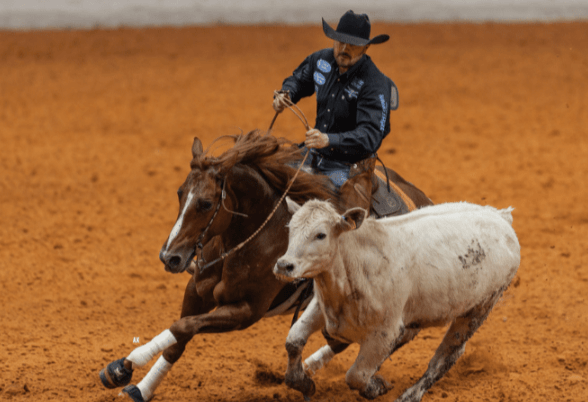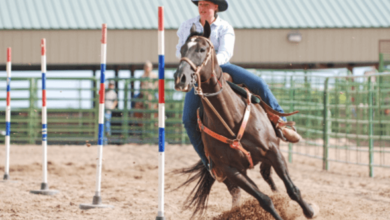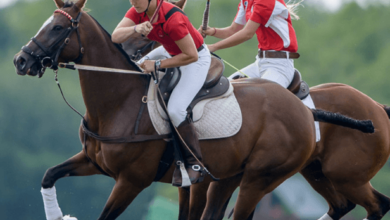Training for a team penning event requires a blend of strategic planning, rigorous practice, and strong teamwork. Team penning is a fast-paced equestrian sport where three riders work together to separate specific cattle from a herd and guide them into a pen within a set time limit. The sport demands quick thinking, precise control of the horse, and seamless coordination among team members. In this article, we will explore how a team can prepare effectively for a team penning competition, from mastering the basics to refining advanced techniques.
Understanding the Key Skills Required for Team Penning
Before diving into training routines, it’s crucial to understand the fundamental skills that make a successful team penning participant:
- Horsemanship: Riders must have strong riding skills, including the ability to control their horses with precision and maintain a strong bond with their mount.
- Cattle Handling: Knowledge of how cattle move and react is essential. Riders need to anticipate movements and use pressure and positioning to direct the cattle effectively.
- Team Coordination: Effective communication and synchronization among team members are vital. A well-coordinated team can cut out cattle quickly and guide them into the pen with minimal confusion.
Building a Training Routine for Team Penning
A structured training routine is crucial for any team looking to excel in team penning. The routine should focus on building core skills, fostering teamwork, and preparing the horses for the challenges of competition.
Start with Horse Conditioning
The horse plays a pivotal role in team penning, and conditioning is the first step in training. The goal is to ensure the horse is agile, responsive, and capable of maintaining a high level of performance throughout the event.
- Cardio Training: Engage in activities like trotting, cantering, and galloping to build the horse’s endurance. Cardiovascular fitness is essential, as team penning requires bursts of speed and stamina.
- Agility Drills: Use maneuvers such as figure eights, rollbacks, and sharp turns to improve the horse’s agility. The ability to make quick turns and stops is crucial when separating cattle.
- Desensitization Training: Exposure to loud noises, quick movements, and close contact with cattle can help a horse remain calm during the chaos of a team penning event.
Develop Cattle Sorting Skills
Cattle sorting is the heart of team penning, and training sessions should focus on the skills needed to separate specific cattle from a herd.
- Practice with Herds: Begin with small herds to practice cutting out specific cattle. Gradually increase the size of the herd as the team’s skills improve. This helps riders learn to spot and separate the designated cattle quickly.
- Simulate Competition Scenarios: Create mock runs with a time limit to replicate the pressure of a real competition. This helps the team learn to stay calm under time constraints and make quick decisions.
- Control Techniques: Work on using body positioning and pressure to control the direction in which cattle move. Riders should practice how to use their horses to apply pressure to the cattle’s flight zones, encouraging them to move toward the pen.
Focus on Team Communication and Strategy
A strong team in penning is defined by its ability to communicate effectively and work together as a unit. During training, teams should practice:
- Clear Signaling: Develop a system of verbal and non-verbal signals to communicate with each other during the run. This might include hand signals or specific phrases to indicate when to move or hold back.
- Role Assignments: Determine which rider will take on which role—sorting, driving, or penning. While roles can be fluid during a run, having a clear plan helps the team function more smoothly.
- Strategic Planning: Discuss and plan different approaches for various herd setups. This includes deciding who will enter the herd first, which direction to drive the cattle, and how to position riders near the pen for a smooth finish.
Improve Timing and Speed
Speed is a crucial factor in team penning, as teams are often competing against the clock. Here’s how to build speed without sacrificing control:
- Short Burst Drills: Practice quick sprints followed by sudden stops to mimic the movements needed in a team penning event. This helps horses become comfortable with changing speeds rapidly.
- Timed Practices: Regularly time practice runs to track progress. Set goals for improving time while maintaining the accuracy of separating and penning the correct cattle.
- Refine Turns and Stops: Work on refining the horse’s ability to make tight turns and rapid stops, which can shave valuable seconds off the team’s run time.
Build Trust Between Rider and Horse
The connection between the rider and horse is a cornerstone of success in team penning. Building trust and responsiveness is key to effective training.
- Groundwork: Spend time on groundwork exercises that build the horse’s responsiveness to subtle commands. This includes leading, yielding, and moving the horse’s hindquarters and forequarters on the ground.
- Consistency in Cues: Use consistent cues during training to avoid confusing the horse during competition. This ensures that the horse understands what is being asked of it when under pressure.
- Relaxation Techniques: Include relaxation exercises to ensure the horse remains calm and focused. This can help prevent nervousness or agitation during high-pressure moments in competition.
Preparing for the Competition Environment
Training in a familiar environment is different from performing in an actual competition. Preparing for the unpredictability of a new arena is a critical part of a successful training regimen.
- Exposure to Different Arenas: Practice in different locations if possible, to help both riders and horses become comfortable with unfamiliar surroundings. This can prevent distractions during the actual event.
- Work with Varied Cattle: Training with different types of cattle can help the team adapt to variations in size, speed, and temperament. This helps riders understand how different cattle may react during a competition.
- Simulate Noise and Crowds: Introducing elements such as loudspeakers or spectators during training can help desensitize horses to the distractions they might encounter at a live event.
Mental Preparation for Riders
In addition to physical training, mental preparation is equally important. Team penning can be stressful, and riders need to maintain focus and composure.
- Visualization Techniques: Encourage riders to visualize successful runs. This helps in building confidence and preparing mentally for the competition.
- Focus on Positivity: Building a positive team culture can reduce stress and foster better communication. Riders should support each other and focus on constructive feedback during training.
- Breathing Exercises: Practice deep breathing techniques to maintain calm during high-pressure moments. This can help riders remain relaxed and make better decisions during the run.
Evaluating Progress and Adjusting Training
Regular evaluation of progress is important for a successful training program. This involves:
- Reviewing Videos of Practice Runs: Recording practice sessions and reviewing them helps identify mistakes and areas for improvement. Riders can see where they need to adjust their positioning or improve communication.
- Setting Incremental Goals: Break down training into smaller, achievable goals, such as improving time by a few seconds or successfully penning all three cattle in more practice runs.
- Adapting Strategies: Be flexible with training methods and strategies. If a particular approach isn’t working, don’t hesitate to adjust it to suit the strengths and weaknesses of the team.
Common Training Mistakes to Avoid
While training for team penning, it’s important to be aware of potential pitfalls that could hinder progress:
- Overworking Horses: Horses need time to rest and recover. Overworking can lead to injuries or burnout, negatively affecting their performance.
- Ignoring Communication: Teams that neglect to work on communication often struggle during competition. Prioritize teamwork and spend time developing clear communication channels.
- Lack of Variety in Training: Sticking to the same training routine without variation can lead to complacency. Keep training sessions engaging by introducing new drills or working with different herds.
Conclusion
Training for a team penning event is a rewarding process that requires dedication, strategic thinking, and strong teamwork. By focusing on conditioning, improving cattle handling skills, and refining team communication, a team can prepare effectively for the challenges of competition. With consistent practice and a focus on building trust between horse and rider, any team can enhance their performance and enjoy the thrill of the sport.





